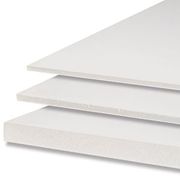Difference between revisions of "Gatorfoam"
| Line 3: | Line 3: | ||
== Description == | == Description == | ||
| − | [3A Composites, formerly owned by International Paper Co.] A registered trademark for a laminated foamboard. GatorFoam® is made from a rigid polystyrene core laminated with | + | [3A Composites, formerly owned by International Paper Co.] A registered trademark for a laminated foamboard. GatorFoam® is made from a rigid polystyrene foam core laminated between two facing papers consisting of wood fiber impregnated with resin. The strong, flat panels are water-resistant and dimensionally stable. Direct sunlight will cause bleaching and degradation of any unprotected foam. GatorFoam® is not made as an archival product and may emit acidic vapors. |
== Synonyms and Related Terms == | == Synonyms and Related Terms == | ||
| Line 10: | Line 10: | ||
== Applications == | == Applications == | ||
| − | + | Gatorfoam is used as a working surface for artist to support pastels, paintings and other media. It is commonly used to stretch water color paper. Gatorfoam is used in exhibition and displays as a backing board and mounting surface. | |
== Personal risks == | == Personal risks == | ||
| − | + | * Under high heat can produce aromatic hydrocarbons including, styrene, ethyl benzene and other polymer fragments. | |
| + | * May contain minute amounts of [[formaldehyde]]. | ||
| + | * Skin and Eye Contact, Inhalation: Dust may cause irritation. | ||
| − | 3A Composites: [[https:// | + | 3A Composites: [[https://www.gogsg.com/ASSETS/DOCUMENTS/ITEMS/EN/GATBLK12-4896%20sds.pdf| Safety Data Sheet]] |
== Collection risks == | == Collection risks == | ||
| − | May emit acidic vapors. | + | May emit acidic vapors. Increased off-gassing can occur with high heat and moisture. |
| + | |||
| + | Oddy Testing Link: http://www.conservation-wiki.com/wiki/Oddy_Test_Results:_Case_Construction_Materials | ||
| + | |||
| + | ==Environmental Risks== | ||
| + | Material Is not biodegradable. | ||
| + | |||
| + | == Working Properties== | ||
| + | Gatorfoam can be cut with a utility knife, saw or router. | ||
| + | |||
| + | ==Exhibit Construction Reviews/Tips/Case Studies== | ||
| + | AIC Link about Backing Inserts (http://www.conservation-wiki.com/wiki/Stretchers_and_Strainers:_Materials_and_Equipment ) | ||
== Forms/Sizes == | == Forms/Sizes == | ||
| − | Gator-Foam® is available in | + | Gator-Foam® is available in black and white colors in a range of sizes and thicknesses. Some available sizes include (Dick Blick): |
| + | * 16” x 13” x ½” | ||
| + | * 23 x 31” x ½” | ||
| + | * 32 x 40” x 3/16” | ||
| + | * 32 x 40 x ½” | ||
| + | * 48 x 96” x ½” | ||
| + | |||
| − | == | + | == Resources and Citations == |
* Pam Hatchfield, ''Pollutants in the Museum Environment'', Archetype Press, London, 2002 | * Pam Hatchfield, ''Pollutants in the Museum Environment'', Archetype Press, London, 2002 | ||
Revision as of 10:08, 31 July 2020
Description
[3A Composites, formerly owned by International Paper Co.] A registered trademark for a laminated foamboard. GatorFoam® is made from a rigid polystyrene foam core laminated between two facing papers consisting of wood fiber impregnated with resin. The strong, flat panels are water-resistant and dimensionally stable. Direct sunlight will cause bleaching and degradation of any unprotected foam. GatorFoam® is not made as an archival product and may emit acidic vapors.
Synonyms and Related Terms
Gator-foam (sp); Gatorplast [Alcan Composites]; Gatorboard
Applications
Gatorfoam is used as a working surface for artist to support pastels, paintings and other media. It is commonly used to stretch water color paper. Gatorfoam is used in exhibition and displays as a backing board and mounting surface.
Personal risks
- Under high heat can produce aromatic hydrocarbons including, styrene, ethyl benzene and other polymer fragments.
- May contain minute amounts of Formaldehyde.
- Skin and Eye Contact, Inhalation: Dust may cause irritation.
3A Composites: [Safety Data Sheet]
Collection risks
May emit acidic vapors. Increased off-gassing can occur with high heat and moisture.
Oddy Testing Link: http://www.conservation-wiki.com/wiki/Oddy_Test_Results:_Case_Construction_Materials
Environmental Risks
Material Is not biodegradable.
Working Properties
Gatorfoam can be cut with a utility knife, saw or router.
Exhibit Construction Reviews/Tips/Case Studies
AIC Link about Backing Inserts (http://www.conservation-wiki.com/wiki/Stretchers_and_Strainers:_Materials_and_Equipment )
Forms/Sizes
Gator-Foam® is available in black and white colors in a range of sizes and thicknesses. Some available sizes include (Dick Blick):
- 16” x 13” x ½”
- 23 x 31” x ½”
- 32 x 40” x 3/16”
- 32 x 40 x ½”
- 48 x 96” x ½”
Resources and Citations
- Pam Hatchfield, Pollutants in the Museum Environment, Archetype Press, London, 2002
- 3A Composites Product sheet: https://d371dyuip757b1.cloudfront.net/downloads/3A_SalesSheet-GATOR.pdf%7C
